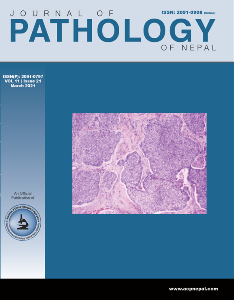Histopathological spectrum of salivary gland lesions in rural India
DOI:
https://doi.org/10.3126/jpn.v11i1.32442Keywords:
Mucoepidermoid carcinoma; Pleomorphic adenoma; Parotid gland; Sialadenitis;Abstract
Background: Salivary gland lesions are of a wide spectrum and affect all the major and minor salivary glands in varying proportions. This study, performed in a rural medical college in Maharashtra, India is intended to see the histopathologic spectrum of salivary gland lesions in the rural population and how it is related to the data from other parts of the country and of the world.
Materials and Methods: This is a retrospective study done in the Department of Pathology of a rural-based medical college, Indian Institute of Medical Science and Research, Warudi, Maharashtra, India for a period of 6 years, from January 2014 to January 2020. Age, sex, location of the lesion, gross and microscopic findings were noted.
Results: A total of 71 lesions were received in the department of pathology during this period. Samples were received from age 11 years to 75 years. Female preponderance with a male: female ratio of 1:1.15 was seen. 57.7% (n=41) were benign, 15.5% (n=11) were malignant and the rest (n=19) were inflammatory in nature. A maximum number of lesions (50.7%) were detected in the Parotid gland. The most common lesion seen was Pleomorphic adenoma (36.62%, n=26) and the most common malignant lesion was Mucoepidermoid carcinoma.
Conclusions: Present study showed benign and non-neoplastic lesions outnumbering the malignant lesions, with female predominance, and a low mean age for malignant lesions of 38.2years. Comparison with other studies within and outside India showed a similar pattern of distribution of salivary gland lesions in the rural population.
Downloads
Downloads
Published
How to Cite
Issue
Section
License
This license enables reusers to distribute, remix, adapt, and build upon the material in any medium or format, so long as attribution is given to the creator. The license allows for commercial use.




